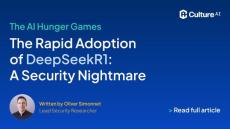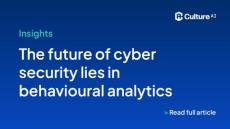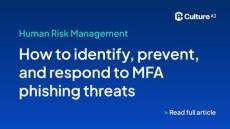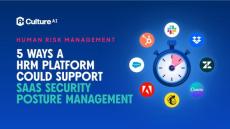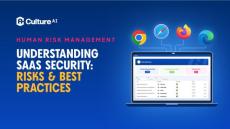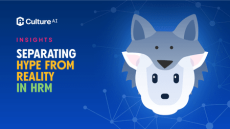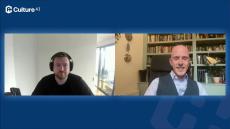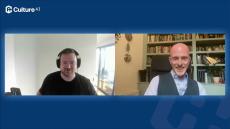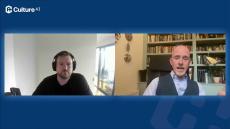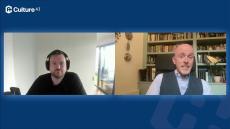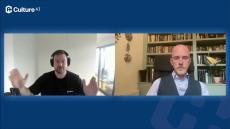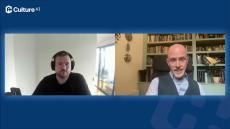|
By Oliver Simonnet
The recent rapid adoption of the AI application “DeepSeek” has gained significant global attention. Becoming the app on both the Apple Store and Google Play Store within its first few days, seeing over 10 million downloads. While this explosive growth of DeepSeek R1 highlights the public’s fascination with AI-driven tools, the security community and policymakers have been less enthusiastic.
|
By The CultureAI Team
Behavioural analytics in cyber security has emerged as a powerful tool for identifying and mitigating human risks. By focusing on how humans interact with systems, user behavioural analytics offer a proactive approach to threat detection, ensuring a more secure digital environment for businesses.
|
By The CultureAI Team
Cyber security threats are increasingly complex, and while external attacks like phishing and malware often take centre stage, insider threats are emerging as a significant concern. Insider threats are risks originating from within an organisation, which pose unique challenges. They exploit an insider’s knowledge of systems, processes, and vulnerabilities, making detection and prevention particularly challenging.
|
By The CultureAI Team
In an era where password breaches have become all too common, Multi-Factor Authentication (MFA) has emerged as a critical layer of security. MFA provides an authentication method that requires users to present multiple forms of identification before gaining access to systems, which is considered a more robust defence against cyber attacks. However, as cyber criminals evolve tactics, MFA is no longer impervious to threats, particularly phishing attacks that exploit vulnerabilities.
|
By The CultureAI Team
Software as a Service (SaaS) applications have become indispensable for organisations in today's digital landscape. From collaboration tools enabling better communication, to SaaS applications that streamline operations, enhance productivity, and support remote work. However, their convenience comes with significant security challenges—many of which stem from human errors, insider threats, and inadequate configuration practices.
|
By The CultureAI Team
Shadow IT refers to the use of information technology systems, devices, software, applications, and services without explicit approval from an organisation's IT department. While it sounds sinister, and has certain implications, it is not always done maliciously or with the intent of breaching security. It encompasses a wide range of digital activities where employees leverage unapproved tools to be more productive or achieve specific goals.
|
By The CultureAI Team
Software as a Service (SaaS) applications have become widespread and indispensable for businesses of all sizes, and for good reason. The convenience, flexibility, and scalability mean teams can access the essential tools and data from anywhere around the globe. This convenience and accessibility, however, does pose its own set of challenges when it comes to security risks.
|
By John Scott
Human risk management (HRM) has become a more established category in recent years. This development signals a crucial shift towards enabling security teams to accurately quantify and manage workplace risks. With the rise of HRM, a variety of new technologies have also emerged on the market. However, how do you navigate the sea of buzzwords and shiny promises to pick the solution that's right for you?
|
By John Scott
I've spent over 35 years as a trainer in various capacities, so it might surprise you to hear me say that training alone isn't enough to change behaviours—particularly when it comes to security. This isn't just my opinion; it's a conclusion from our State of Human Risk Management in 2024 Report. To understand why training isn't the full solution, we need to delve into the field of human error. Mistakes—errors caused by wrongly applied knowledge—can often be corrected with training.
|
By John Scott
October 1st marks the start of Security Awareness Month. A global campaign launched two decades ago to improve cyber security awareness and equip people with the knowledge and resources they need to be secure online. But what impact has this campaign truly had in the workplace? Yes, it spotlights the issue and boosts high-level awareness of threats like phishing.
|
By CultureAI
Monitor, reduce, and fix your human cyber risks. The CultureAI Human Risk Management Platform enables security teams to proactively monitor human risk across multiple applications, providing immediate visibility into the riskiest employee behaviours and security vulnerabilities within an organisation.
|
By CultureAI
Discover:✅ Why even the savviest individuals struggle to avoid phishing traps, especially amidst multiple software sign-ups and cloud managed services. ✅ From an organisation's standpoint, why acknowledging and reporting phishing attempts, like John's simulated case, is a crucial step towards better security.
|
By CultureAI
Discover:✅ Why even the savviest individuals struggle to avoid phishing traps, especially amidst multiple software sign-ups and cloud managed services. ✅ From an organisation's standpoint, why acknowledging and reporting phishing attempts, like John's simulated case, is a crucial step towards better security.
|
By CultureAI
Discover:✅ Why even the savviest individuals struggle to avoid phishing traps, especially amidst multiple software sign-ups and cloud managed services. ✅ From an organisation's standpoint, why acknowledging and reporting phishing attempts, like John's simulated case, is a crucial step towards better security.
|
By CultureAI
Discover:✅ Why even the savviest individuals struggle to avoid phishing traps, especially amidst multiple software sign-ups and cloud managed services. ✅ From an organisation's standpoint, why acknowledging and reporting phishing attempts, like John's simulated case, is a crucial step towards better security.
|
By CultureAI
Discover:✅ Why even the savviest individuals struggle to avoid phishing traps, especially amidst multiple software sign-ups and cloud managed services. ✅ From an organisation's standpoint, why acknowledging and reporting phishing attempts, like John's simulated case, is a crucial step towards better security.
|
By CultureAI
Discover:✅ Why even the savviest individuals struggle to avoid phishing traps, especially amidst multiple software sign-ups and cloud managed services. ✅ From an organisation's standpoint, why acknowledging and reporting phishing attempts, like John's simulated case, is a crucial step towards better security.
|
By CultureAI
Discover:✅ Why even the savviest individuals struggle to avoid phishing traps, especially amidst multiple software sign-ups and cloud managed services. ✅ From an organisation's standpoint, why acknowledging and reporting phishing attempts, like John's simulated case, is a crucial step towards better security.
|
By CultureAI
Discover:✅ The current state of the security awareness and training market✅ The future of Human Risk Management and how it is evolving✅ The importance of defining job roles in Human Risk Management.
|
By CultureAI
Discover:✅ The current state of the security awareness and training market✅ The future of Human Risk Management and how it is evolving✅ The importance of defining job roles in Human Risk Management.
- February 2025 (1)
- January 2025 (4)
- December 2024 (1)
- November 2024 (1)
- October 2024 (3)
- September 2024 (1)
- August 2024 (1)
- July 2024 (2)
- June 2024 (3)
- April 2024 (3)
- March 2024 (1)
- February 2024 (1)
- December 2023 (1)
- October 2023 (1)
- July 2023 (11)
- June 2023 (5)
CultureAI’s innovative Human Risk Management Platform empowers you to identify security risks, educate employees in real time, and nudge them to make immediate fixes.
Strengthen resilience against phishing, improve SaaS security, reduce data loss through generative AI, and more. We help security teams identify and manage their most prominent employee security risks in one comprehensive platform.
End-to-end Human Risk Management:
- Monitor 40+ Human Risks: Surface, track and manage risks created by employees and understand where you're vunerable.
- Security Coaching: Reduce the number of risky behaviours using risk data to drive personalised coaching that improves behaviour.
- Automated Interventions: Where possible, reduce risks further by automatically mitigating employees' risky behaviour.
- Security Nudges: Just-in-time notifications that nudge employees to their own risks and offer one-click solutions.
The #1 platform to improve cyber security behaviours and reduce security incidents caused by employees.


